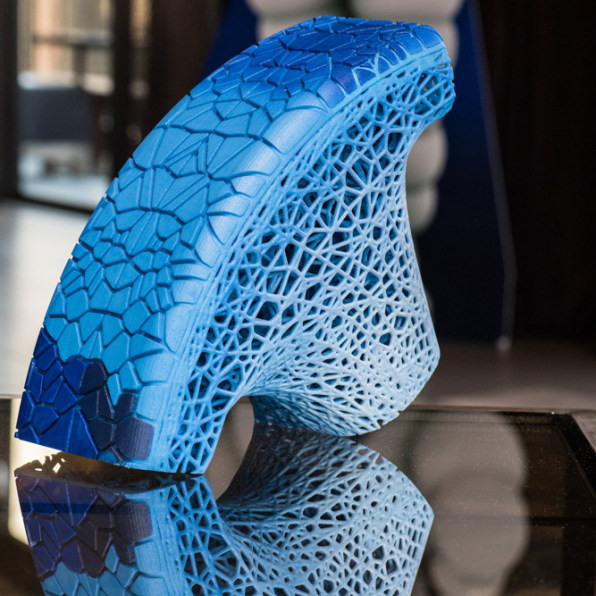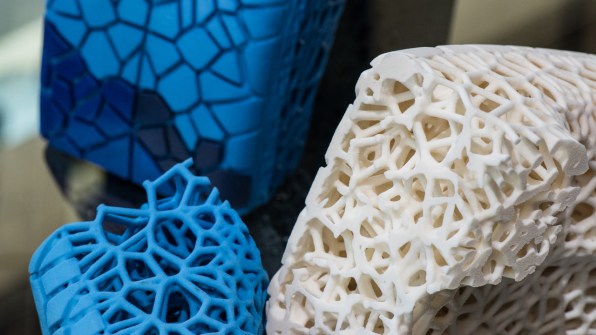The VISION, a new tire-wheel combination from Michelin, means the clean car of the future can have clean tires, as well.
In recent years, there’s been an undeniable explosion in talk about the automobile of the future. It’ll be self-driving, we imagine, powered by electricity instead of gas. It’ll be silent, efficient, catering to our every need as passengers (even, in the case of this Mercedes, going so far as to offer a full spa treatment). But rarely is similar attention devoted to the thing that propels these vehicles forward: the tire.
Granted, “tire of the future” does have quite the same consumer appeal as “car of the future,” but Michelin is making the case for the category nonetheless. And for good reason: Anywhere from 15 to 38 liters of petroleum are required to produce standard tires, which, once worn through, often make their way to landfills, where they decompose and release hazardous toxins into the soil and atmosphere.

The new Michelin VISION conceptis a 3D-printed, airless, wheel-tire combination composed of organic, biodegradable materials, including orange zest, bamboo, molasses, wood, and natural rubber. Instead of a runner inner tube that maintains its structure with regular injections of air, the VISION is more solid, sponge-like structure–picture a 3D spiderweb, molded into the shape of a wheel. While the weblike structure is still a prototype–Terry Gettys, Michelin’s global head of R&D, tells Fast Company they’re looking at a 10-to-20-year rollout process–it signals an important new area for innovation in the transportation sector.Work on VISION, Gettys says, began about a year and a half ago, and has entailed devising ways to switch out components of traditional tires for naturally derived ingredients. Instead of relying on petroleum to create the synthetic rubber needed for tires, Gettys describes how molasses can achieve a similar aim. “From the sugar from molasses, we can develop ethanol; from ethanol we can create the synthetic rubber that today, in 75% of tires, is derived from petroleum,” Gettys says. “It’s good for the environment to have a renewable source, but it’s also higher-performing.”
First unveiled at the Movin’ On mobility conference in Montreal in June, the VISION also, Gettys says, represents more sustainable option because of the way the wheel and tire are fused into one biodegradable, nature-inspired structure. Instead of having to dismantle the tire and rims and bring them to separate outlets to try to recycle them, the VISION can be recycled as a single unit, and will decompose naturally without harming the environment.
But busted VISIONS will not accumulate in landfills like our current tires do. Because it is airless, the VISION will never blow out and never needs to be replaced. Instead, it can be “recharged” as often as necessary with a new layer of treads; the 3D-printed treads can be tweaked to adapt to weather and road conditions. Gettys visualizes, instead of the flat-fix and tire-change shops you haul your vehicle to before heading into the mountains, a network of service stations that can use targeted 3D-printers to add a new layer of treads to the tire to adapt to new conditions. “The tread compound, the outer layer, is very thin and designed to wear out and be replaced so you can tune it to your needs,” Gettys says. The VISION will also contain sensor chips to gather information on the experience and usage of the tires.

“We wanted to design an object that represents Michelin’s commitment to sustainable mobility,” Gettys says. The VISION is a concept meant to encapsulate what it means to build a tire while remaining mindful of the need to cut back on the use of scarce or harmful components, and also to design something that will not contribute to landfill at the end of its life cycle. Even though it likely won’t hit consumer markets for another decade–and Gettys anticipates further tweaks to the prototype along the way–it points to how tire manufacturers can begin to think more sustainably.Of course, the VISION, like all future-looking concepts, raises questions about jobs in the tire industry: What will happen to people accustomed to the assembly-line factory process, or the requirements of the flat-fix shop, when 3D-printing machines take over? That, Gettys says, is something that Michelin will have to consider, whether that be through transitional job-training programs or another solution. But the long market roll-out process for the VISION, Gettys says, will give the company more time to consider how its development will affect the whole industry ecosystem. “You don’t transform an industry overnight,” he says.

